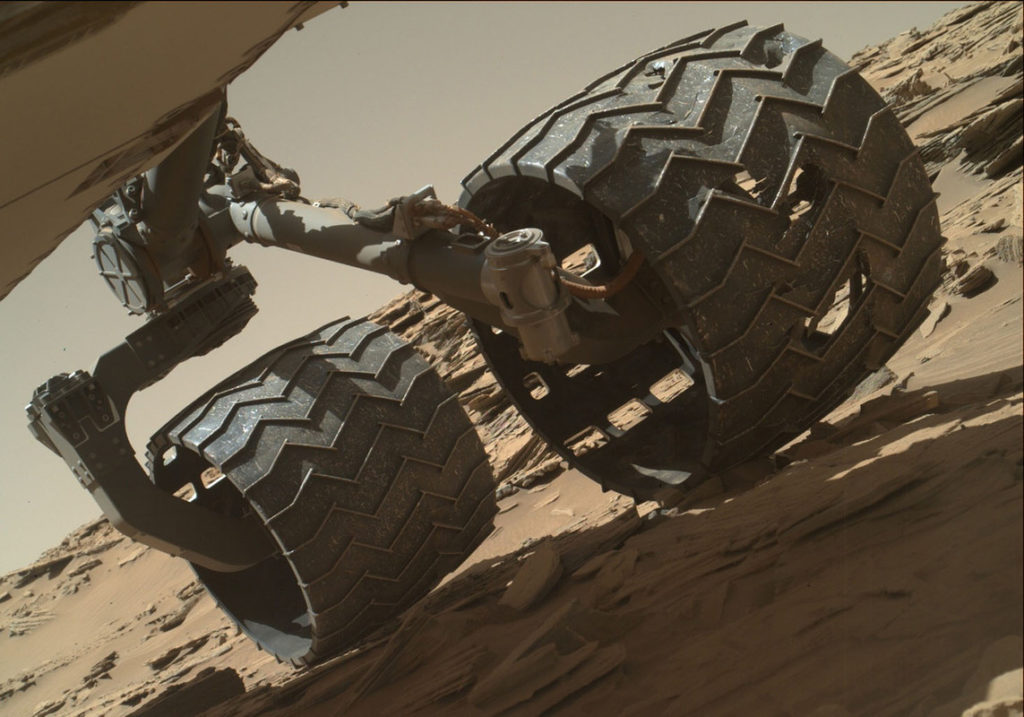As the Mars Perseverance rover also know as Mars 2020 is ready for the launch by end of these month. Let’s look at the Mars Curiosity rover how many days does the spacecraft left.
On the 24th of January 2004, the Opportunity rover touched down on the surface of Mars. Opportunity was one of two rovers tasked with finding ancient evidence of water on the Martian surface.
After travelling 22.97 Km over the incredible Martian landscape, it did exactly that. Despite a life expectancy of just 90 days, Opportunity ended up working on Mars for an incredible 14 years before succumbing to an enormous dust storm in 2018.
Although Opportunity’s time has come to an end, its incredible scientific discoveries live on in NASA’s ‘Curiosity’ rover. After a six-month journey through space, Curiosity finally made Mars its home when it touched down on the 6th of August 2012.
Armed with an array of advanced tools, Curiosity looked to make new discoveries about the Martian climate and the geological processes that shaped Mars over its lifetime.

Since arriving on Mars, Curiosity’s main focus has been on Gale crater, which had been an area of high interest for scientists.
Almost right away, Curiosity found strong evidence that this crater was once filled with water. In the past, rivers of liquid water would have flown into the crater carrying sand, silt and gravel along with it.
Over time, these layers would build up and compress into rock – leaving a snapshot in time for Curiosity to discover.
In order to further examine these ancient formations, Curiosity drilled into the lake bed and discovered several types of organic compounds.
These are chemical compounds that contain carbon, one of the most common elements found in life on Earth.
Although there is a lot of carbon in our solar system that doesn’t originate from life, this was a good sign that microbial life could have existed on Mars billions of years ago.
Curiosity continues to travel around Gale crater, discovering interesting formations and analyzing rock samples. So far, Curiosity has traveled 22.97 km across the Martian surface but it hasn’t all been smooth sailing.
Over the last 7 years, the rough Martian terrain has caused a significant amount of damage to Curiosity’s wheels.
This is just one of the many problems that threaten Curiosity on the Martian surface. In order to reduce tyre wear, the engineers that control the rover have started to re-route Curiosity on its journey, to avoid the harshest of terrain.

Curiosity remains in close communication with Earth via the Deep Space Network, which consists of antenna complexes at three locations around the world.
The rover uses a steerable high-gain antenna which can be pointed directly towards Earth. The data rates when talking directly to Earth are slow, so Curiosity often sends its data through the Mars Reconnaissance Orbiter.
This orbiter passes over the rover for around 8 minutes each day. In that short period of time, Curiosity can send around 30 megabytes of data up to the orbiter which can then pass it onto Earth.
If Curiosity was to send the same amount of data directly to Earth, it would take 20 hours. Communicating directly with Earth also uses a lot of power from the spacecrafts batteries.
So, sending information can only be done for a few hours per day. Curiosity is powered by a radioactive thermoelectric generator. This works by converting heat from radioactive isotopes into electricity.
This electricity charges two lithium-ion batteries, allowing Curiosity to carry out high power tasks each day.
The RTG is expected to fully power Curiosity until at least 2026. After that, the power will decrease and the amount of movement and science it can perform Although Curiosity will continue to limp on, it’s entirely possible that mechanical failure or the Martian weather might stop Curiosity’s exploration before its power runs out.
A Martian dust storm, much like the one which silenced Opportunity, may also be the end of Curiosity’s mission.
Dust storms on Mars form clouds which can reach up to 100 km above the surface of the planet. The dust particles which circulate during these storms are small and slightly electrostatic.
So, they can often stick to the rovers surfaces and interfere with electrical components.
Curiosity is just one of many rovers which will, in time, come to explore the endless bounds of space. The Mars 2020 rover is set to launch on July 30th if everything go well and NASA told they have 17 days window for the launch and if they miss it then the earliest window available is late 2022.
And the rover is expected to land on Mars in early 2021. While Curiosity was sent to Mars to discover habitable conditions, the 2020 mission takes things a step further – and hopes to find real proof of microbial life.
Mars rovers are becoming more complex, more intelligent and more useful. And while Curiosity may have many years left to roam, its electrical power weakens each day and the threat of dust storms could easily be the end for Curiosity.
Over time, engineers will slowly start shutting off instruments to preserve power, until Curiosity sends its last bit of data and disappears silently into the Martian landscape.
Either way, we can appreciate the enormous amount of information that Curiosity has collected on Mars and the incredible journey it’s been on to get there.
Additional Resources
Related tags
real mars, opportunity’s, curiosity, curiositys, rover for mars, rover in mars, rover mars, mars rovers, rovers mars, mars ro, mars rover, rover on mars, rover to mars, rovers on mars, rovers to mars, lander on mars, rover curiosity, the curiosity rover, curiosity the rover, curious rover
